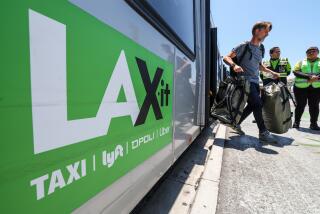Report Citing Substandard L.A. Taxi Service May Aid Firm’s Effort to Join Competition
- Share via
As a fight heats up over putting more cabs on Los Angeles’ streets, a new city report charges that taxi service in a wide area is “below city standards” and is “unacceptable” in neighborhoods ranging from affluent Pacific Palisades to working class El Sereno and Highland Park.
The city Department of Transportation report, obtained by The Times, is expected to be cited today when the City Council Transportation and Traffic Committee considers a new company’s application to add 95 cabs to the 1,068 now permitted to operate in Los Angeles. Officials estimate that, in addition, there are about 600 unauthorized cabs on the streets.
The application of the new Bell Cab Cooperative to operate on the Westside and in central Los Angeles has touched off intense opposition from five companies that already have fleets on the streets.
Opposing Bell are the Independent Cab Co., L.A. Taxi, the Wilmington Cab. Co., the Beverly Hills Cab Co. and L.A. Checker Cab Co.
Within City Hall, the dispute has become a major issue involving lobbyists whose personal connections with council members, and the ability to steer campaign contributions to lawmakers, have made them an important force in making city policy.
The Department of Transportation report, signed by General Manager Donald R. Howrey, recommended that Bell Cab be allowed to operate in a wide area running from the beaches on the west to Eagle Rock, El Sereno and Highland Park in the eastern part of the city.
The area contains some of the poorest parts of Los Angeles, including crowded immigrant neighborhoods just west of the Harbor Freeway, and the richest, such as Bel-Air. It also covers most of the big hotels downtown and on the Westside, and large numbers of office buildings. The hotels and the offices generate lucrative cab trips to and from Los Angeles International Airport.
The department made 750 calls to test service in August and September in the four taxicab districts in which Bell wants to operate. The tests showed that there was a need for improvement in most of them. These were the findings, listed by city-designated cab districts:
- B1--Beverly Hills to the San Diego Freeway, including West Los Angeles, Westwood, Century City and Bel-Air. Seventy-four percent of all requests were answered within 15 minutes. In residential areas, the total was 77%, in commercial areas 70%.
- B2--San Diego Freeway to the Pacific Ocean, including Westchester, Mar Vista and Pacific Palisades. Fifty-eight percent of all requests were answered within 15 minutes in commercial and residential areas. “This figure is unacceptable,” the report said.
- C--Santa Monica Freeway to Griffith Park, Hollywood to downtown. Residential areas had 72% of requests answered within 15 minutes and commercial areas 73%. “Improvement is needed,” the report said.
- C1--Eagle Rock, Highland Park, El Sereno, Boyle Heights and Lincoln Heights. This working-class, heavily Latino area had 41% of all calls answered within 15 minutes, with residential areas having a 40% rate and commercial 41%. City regulators called the totals “unacceptable.” The report said “this area produced the largest number of no-shows (no cab response) as 20% of the requests were not serviced.”
- C2--La Brea Avenue to Beverly Hills. Sixty-nine percent of calls from residential areas answered in 15 minutes; 86% for commercial.
Prefer Long Hauls
The report echoed past findings that Los Angeles cab drivers appear to prefer to wait at hotels or the airport for long hauls rather than answering dispatchers’ calls for trips to residences.
In recommending that Bell be given permission to operate, the Department of Transportation proposed that the initial number of taxicabs be reduced from the 95 Bell requested to 70 and that the company be denied permission to pick up passengers at Los Angeles International Airport.
Those limitations are not likely to satisfy the opponents, who, in anticipation of a fierce council struggle, have hired as lobbyists Burt Pines, a former Los Angeles city attorney; Joseph Cerrell, a longtime Democratic campaign consultant who now represents several big business accounts before the council; Rick Taylor, a former aide to Councilmen John Ferraro and Zev Yaroslavsky, and David Abel, a well-known lobbyist.
Snyder on Bell’s Side
Working for Bell is former City Councilman Arthur K. Snyder, and Leslie Winner, former partner of Taylor, who has put together a publicity campaign.
In addition to its backing in the latest Department of Transportation report, Bell was endorsed by the city Board of Transportation Commissioners.
Bell’s opponents object that Bell is being given special consideration in an attempt to promote a driver-owned cooperative approach to cab operations. They insist that Bell must go through the same expensive application procedures other companies have followed.
Times researcher Cecilia Rasmussen contributed to this article.
More to Read
Sign up for Essential California
The most important California stories and recommendations in your inbox every morning.
You may occasionally receive promotional content from the Los Angeles Times.













